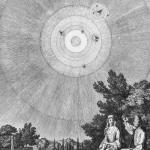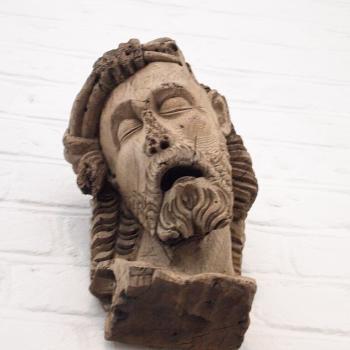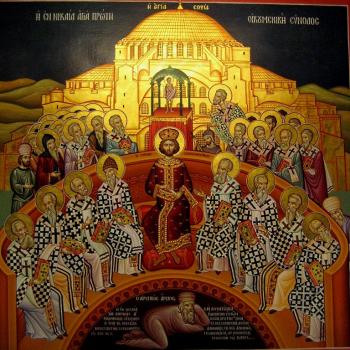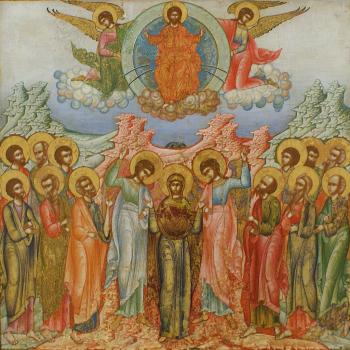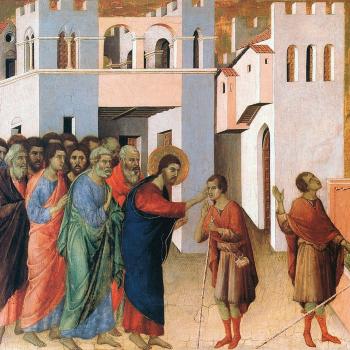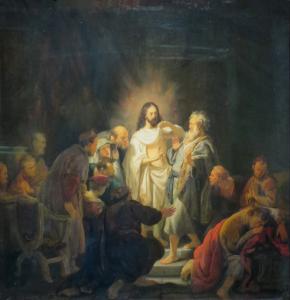
The eighth day. The day after the Sabbath, the seventh day. The eighth day, the day on which Christ rose from the grave. The new and everlasting day. Just as eight follows seven, so the day after the sabbath rest, the day on which Christ rose from the dead, can be said to be the glorious eighth day. It was also the first day of a new week. Until Christ, the end was represented by the Sabbath rest, a rest which could be and was found in death even as it was found in life. There was nothing after the Sabbath rest. But Christ, in bringing things to completion, went beyond the Sabbath rest into the new and everlasting eighth day, the day on which all things are restored and brought into everlasting glory. That is, then, with Christ’s resurrection we find simultaneously the transcendence of the Sabbath rest by the eighth day, and the restoration of all things represented by the newness of the new week. Just like heaven has been found joined with earth, so that the first day and the eighth and eternal day have become one. Time, represented by Sunday, the first day of the week, and eternity, represented by the transcendent eighth day, are joined together. The eschaton has entered time and transformed it, making space for it in eternity.
Eight days after the eighth day, and still, the resurrection is celebrated. Indeed, it is, in a way, repeated, as the great mercy of God, which spreads across all of creation, finds itself coming to and being received by the Apostle Thomas. He had heard that Christ had risen from the dead. He had heard it from the women. He had heard it from the men. He had heard them all, and yet he doubted. He more than doubted, he made it clear he would not believe unless he was given proof himself, and not just any proof, but the kind of proof which could be found only in Jesus’ physical body:
Now Thomas, one of the twelve, called the Twin, was not with them when Jesus came. So the other disciples told him, “We have seen the Lord.” But he said to them, “Unless I see in his hands the print of the nails, and place my finger in the mark of the nails, and place my hand in his side, I will not believe.” Eight days later, his disciples were again in the house, and Thomas was with them. The doors were shut, but Jesus came and stood among them, and said, “Peace be with you.” Then he said to Thomas, “Put your finger here, and see my hands; and put out your hand, and place it in my side; do not be faithless, but believing.” Thomas answered him, “My Lord and my God!” Jesus said to him, “Have you believed because you have seen me? Blessed are those who have not seen and yet believe” (Jn. 20:24-28 RSV).
Eight days later. Eight days after the resurrection on the eight day. That’s when Thomas experienced the glory of the resurrection himself. Eight days. It is without doubt that we are to take notice of the number eight. As the resurrection is on the eighth day, and Thomas becomes a witness of the resurrection eight days later, the number eight should be understood as a symbol that represents the glory of the resurrection itself.
The seventh day, the sabbath rest, is transcended; we should note that the glory of the resurrection transcends mere static rest. Jesus is active in his glory. We must not think of the resurrected state, and the glory of the kingdom of God, to be a state of mere rest, though of course, there are good reasons to see rest as being a fit analogy for that state, because we find the suffering of earthly life transcended. We can say that suffering, and all the stress and anxiety of temporality has been put to rest. Nonetheless the resurrected state transcends the limitations of time and space. But, as Jesus showed us in the time after the resurrection, being beyond time and space does not mean an abandonment of time and space, but rather, something new, where time and space is joined in with eternity and rest and movement are paradoxically united as one. Jesus is active in eternity: and so shall we be: the eight day transcends the sabbath rest, the motionless static life which some conjure up for eternity,
We must not misunderstand this transcendence as being a rejection of rest; its transcendence is one which incorporates what was transcended: such rest is not lost but rather perpetuated by the resurrection, but it is manifested in an active instead of passive mode. Those who follow the risen Lord into glory will also participate in that rest and yet transcend it in their eternal life. The saints are not stuck in heaven; they have been made truly free, no longer bound by time and yet capable of taking it into themselves (how else can they be seen to intercede on behalf of all creation?). How, then, can we say they continue and perpetuate such rest? Because in it, we find ourselves united with God, who is our proper end. We will have attained the eschaton, and so there will be no more earthly struggles filled with sorrow and despair. What we will experience will be our eternal theosis, where we will mysteriously experience constant wonder and transformation in our union with God, forever made greater and greater thanks to his deifying grace. So, just as the first and the last, the first and the eighth day can come together and be one, so in eternity all that is in time and all the motion contained in time will be mysteriously present, and yet the mode of the encounter with time will be so different that it will be said to be rest – and yet it transcends all notion we have of rest, because of the free activity of the saints.
On this, the eighth day after the resurrection, we find in Thomas, a twin who represents us and all our doubts; Jesus did not rebuke him for his doubts, but rather, offered not only his peace but the affirmations which Thomas wanted. In our life, we will likely find ourselves having all kinds of doubts about our faith; when we do, we must remember how Jesus treated Thomas, knowing he will treat us all the same way. Despite all our doubts and confusion, he will come to us offering us his peace. We must not be anxious over our doubts. We must not let them rule us or destroy us. Rather, we must be faithful to Christ according to the state we find ourselves in, and when it is a time of doubt, we must seek after Christ so we can once again receive the gift of peace. We must let ourselves mirror Thomas; we might not receive Christ’s hands, nor place our hands into his side, but we can open ourselves up and be ready for the peace of Christ. That peace which, when we get it, will dispel all doubts even as it will move us to be like Thomas and cry out, “My Lord and My God,” to the one who comes to us in his love.
This is what we should seek: the realization of the resurrection in our life, to experience it, to truly touch Christ through it, and to see and know in a way beyond all intellectual acumen the truth of Christ. Then we will truly be able to free from doubt, because we will not have to rely upon the witness of others Until then we will have doubts, indeed, we will have questions; we might believe in part, and yet in part it can be said we do not: “Whoever has not himself experienced this will never believe another man’s account of it, just as Thomas did not believe the resurrection that was experienced and recounted to him by the apostles until he had experienced it in himself.”[1]
We believe; from time to time, hopefully, we experience a taste, however small, of the resurrection in our lives, giving us the strength to persevere in our faith. It only takes a taste of Christ’s peace in our lives to reaffirm that which we believe. But for all so many of us, that is all we get: a very small portion of that peace. Through the pressures of life, through our faults and sins, our recollection of that taste can vanish, making us once again come to a crisis of faith. Christ knows and understands. Christ will come again and again to us, bringing us his peace. The more we open ourselves up to him and that peace, the more we will receive it within, and the more we will find ourselves knowing the truth of the resurrection, the truth of the kingdom of God. Then, we shall find the truth of Thomas, the truth that he is indeed twin, the twin to all of us, the twin who anticipates and shows us all what we shall receive when Christ comes to us in his resurrected glory.
[1] St. Maximos the Confessor, On Difficulties in the Church Fathers. The Ambigua Volume II. Trans. Nicholas Constas (Cambridge, MA: Harvard University Press, 2014), 259 [Amb. 58].
Stay in touch! Like A Little Bit of Nothing on Facebook.
If you have liked what you read, please consider sharing it with your friends and family!



